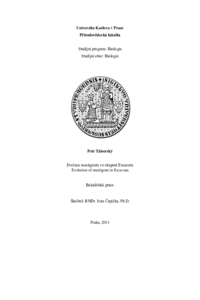Evoluce mastigontu ve skupině Excavata
Evolution of mastigont in Excavata
bakalářská práce (OBHÁJENO)

Zobrazit/
Trvalý odkaz
http://hdl.handle.net/20.500.11956/36630Identifikátory
SIS: 89575
Kolekce
- Kvalifikační práce [19598]
Autor
Vedoucí práce
Oponent práce
Hampl, Vladimír
Fakulta / součást
Přírodovědecká fakulta
Obor
Biologie
Katedra / ústav / klinika
Katedra zoologie
Datum obhajoby
8. 6. 2011
Nakladatel
Univerzita Karlova, Přírodovědecká fakultaJazyk
Čeština
Známka
Výborně
Klíčová slova (česky)
Excavata, ultrastruktura, mastigont, Archezoa, exkavátní znakyKlíčová slova (anglicky)
Excavata, ultrastructure, mastigont, Archezoa, exkavátní znakyAž v poslední době dochází k odhalení obrovské rozmanitosti eukaryotických organizmů. Jednou z velkých skupin jsou Excavata. Zkoumání organizmů této skupiny je velmi důležité jak z teoretického, tak z praktického hlediska. Mnoho autorů se domnívá, že v této skupině leží kořen eukaryot, a svědčí pro to mnohé studie. Náleží sem i organizmy, které mají nejméně odvozený mitochondriální genom. Několik zástupců ze skupiny Excavata jsou významní lidští patogeni. V první části se práce věnuje historickému přehledu utváření taxonomické skupiny Excavata, včetně pojednání o skupině Archezoa. V další části se soustřeďuje na obecný popis mastigontu (bazální tělíska a s nimi spojený cytoskelet z mikrotubulárních i nemikrotubulárních struktur). V poslední části se práce zabývá popisem mastigontu u různě odvozených organizmů ze skupiny Excavata, které mohou být jak volně žijící, tak endobitické.
In recent years we have been discovering a huge diversity of eukaryotic organisms. One of the big super-groups is Excavata. Examination of the organisms from this group is fairly important as far as theoretical and practical reasons are concerned. A significant number of authors believe that there is the root of all eukaryotic organisms in this group. And what is more, a lot of studies prove the point. Within Excavata group we can find the organisms with the most primitive mitochondrial genome which is known. Several other representatives are an important human pathogenes. In the first part of the thesis I focus on the historical review of the creation of the super-group Excavata and I also include a part regarding the theory about Archezoa. The next section deals with the general description of mastigont (basal bodies and cytoskeleton that is associated with them). The last part presents mastigont descriptions of some derived representatives of Excavata. Some of these organisms may be free-living and some live inside other organisms.
